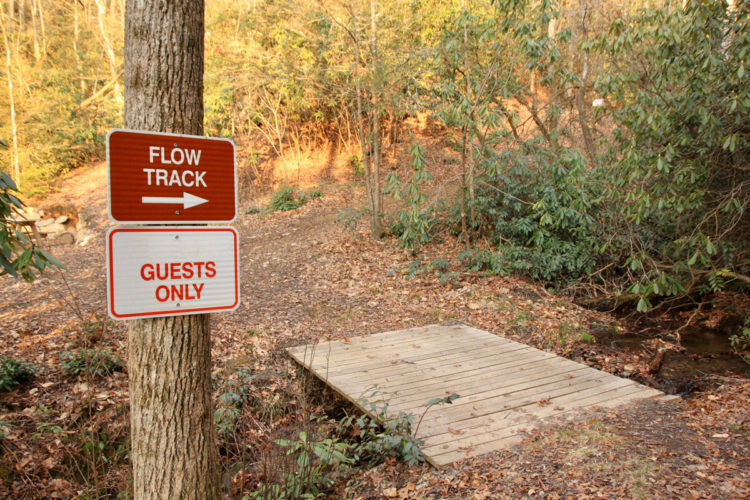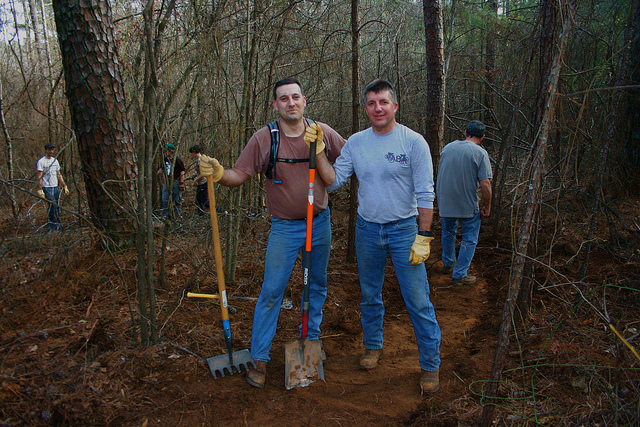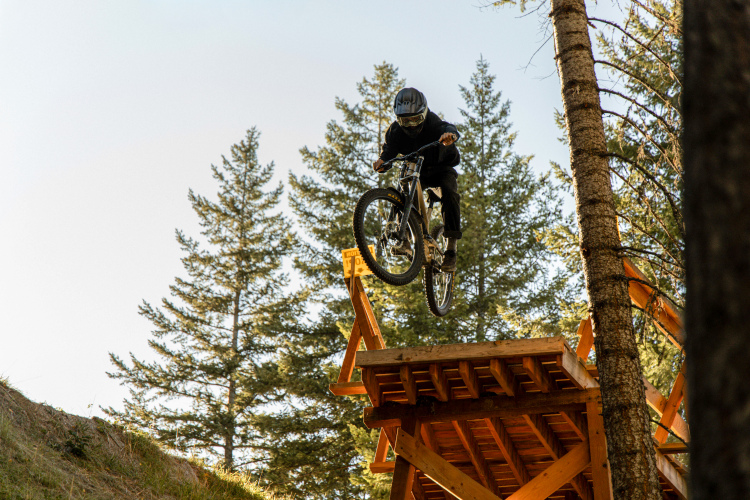
It’s no secret that the era of COVID-19 was a boon to the outdoor recreation economy of the United States.
When lockdowns swept the country, people took to trails and parks in record numbers. Little known state parks became hotbeds of activity. Obscure swaths of public land in the West bloomed with new visitors of all stripes; and they were engaged in the entire spectrum of outdoor recreation — from hiking, fishing, and mountain biking to hunting, foraging, and long-term dispersed camping.
While this well-documented “COVID bump” has largely subsided now, it amplified the number of public land stakeholders from sea to shining sea and left a substantial contingency of new outdoor enthusiasts in its wake. Along with that amplification has come a marked increase in demand for new trails on public land and heightened maintenance needs for existing trail networks — all efforts that require a steady stream of cash and, often, a lot of volunteer sweat and labor.
Because trails aren’t cheap to maintain and even more costly to construct from scratch, public land managers all over the country are searching for new revenue streams to help them keep pace with all of the impending growth.
In Wyoming, officials at the Office of Outdoor Recreation are testing the often fraught, sometimes tepid waters of implementing new user fees that would fund essential trail work. One possible way to go about it, they say, is to charge mountain bikers a fee to ride trails on public lands.
Finding a way for funding
“The idea has been batted around about it being a mountain bike-specific fee, but that’s in no way defined or decided,” Wyoming Outdoor Recreation Office Manager Patrick Harrington told Singletracks. “It depends on what members of the public think.”
Harrington came to his current job after working as the superintendent of Wyoming’s Curt Gowdy State Park, which is home to about 30 miles of popular mountain biking trails. During his time there, he says he watched user numbers skyrocket.
“In 2019 visitation was about 221,000,” he said. “In 2020, it was 620,000, and then last year it dropped slightly to 535,000 — still double what it was pre-pandemic.”
Harrington attributes a sizable portion of that increase to the surging popularity of Curt Gowdy State Park’s mountain bike trail network.
“A lot of that visitation — probably 60 percent — is day use, and a good 50 percent of that was mountain bikers,” he said. “We were definitely seeing growth in both hiking and mountain biking, and I think that bears out across the entire state.”
Since the influx isn’t unique to Wyoming’s state parks — the state’s USFS and BLM lands saw a substantial increase in use during COVID — Harrington wants any discussion of new user fees to encompass federally managed public land as well.
“They’ve certainly asked me to look at something like trail fees in state parks,” he said. “But I think the greatest impact would be across the state in all public lands on all public trail systems, but that’s going to depend exclusively on what people out across Wyoming think is best for the state.”

People who have advocated for new outdoor user fees in the past point to the success of other play-to-play models associated with hunting, fishing, and motorized sports. The Pittman-Robertson Act, for example, which directs federal excise taxes on guns and ammo into the coffers of state wildlife agencies, generated nearly $1 billion for wildlife conservation in 2020 alone, according to the U.S. Department of the Interior.
Proponents say that new user fees could give mountain bikers, and other groups that don’t currently pay upfront fees, some more skin in the game.
But before Harrington and his colleagues at the Wyoming Office of Outdoor Recreation consider implementing any mountain bike-specific user fees, and define the form that such measures could ultimately take, they want to thoroughly gauge the public’s interest.
“We’re looking at a way of generating resources to continue to sustain trail development, and as we sit now, it’s completely and intentionally undeveloped,” Harrington said. “Our goal is, this fall when summer seasons close down, to get out and about in the community and start listening to stakeholders and constituents and see how they feel about it. And ultimately, if they don’t like it, collectively, if people aren’t in support of it, then we won’t pursue it.”
Why Mountain Bikers? They ‘Take of Care of the Stuff Better Than Anybody?’
Brent Skorcz is one of the founders and the acting treasurer of the Sweetwater Mountain Biking Association, a non-profit organization that works to build and maintain mountain biking trails in and around Green River, Wyoming. The idea of a mountain bike-specific user fee doesn’t sit well with him.
“I hate to be negative about it, but I just can’t see it working,” Scorcz said. “Why pinpoint mountain bikers, just picking on them, when we are the ones who probably take care of the stuff better than anybody?”

Scorcz questions the notion of the state charging mountain bikers to ride on federally managed trails that state officials had no hand in creating or maintaining.
“I don’t think Wyoming’s in any position to start charging user fees,” he said. “There’s only a few places that I know that the state has actually put in their own trails. Everywhere else the mountain bikers are doing their own work. All the trails around Green River, nobody from the state has anything to do with it. We put our own trails in. We maintain our own trails.”
He thinks that mountain bike-specific fees, whether they take the form of a state-issued bike decal or a fee for trailhead parking, could ultimately cause out-of-state mountain bikers to forgo Wyoming for other nearby bike-friendly states.
“I ride in Utah all the time. I ride in Colorado all the time. I go down to Sedona and down to Phoenix in the winter time,” he said, “I know I’ve paid for parking in places like Sedona, but as far as a user fee…I’ve never had to buy a tag to stick on my bike to say I can ride in that state. I think it’ll just run more people off, prevent people from coming here if they have to pay to ride on a dirt track or singletrack.”
Members of the Sundance Chain Gang Mountain Biking Association (SCGMBA), based in the northeastern part of the state, echoed Scorcz’s sentiments.
In an email to Singltracks, SCGMBA said its members would not support the imposition of mountain bike-specific fees for riders using National Forest trails.
“If [fees are implemented], then all users should pay,” SCGMBA said in the email. “And equines a more substantial amount due to trail maintenance needs for trail damages and heavy foot traffic.”
The club went on to say that one possible exception would be the construction of purpose-built bike or terrain parks on federal or state land.
“If a national forest or state park builds a bike [or] terrain park, we do believe it is necessary for fees to be charged to facilitate upkeep and maintenance,” SCGMBA said. “[But] we know that this will never happen. Our club members work or worked at federal agencies, and we know the limitations.”
Precedence and a different approach
This isn’t the first time Wyoming state officials have explored the concept of mountain bike-specific user fees. In 2017, the Wyoming State Legislature voted down a bill that would have required decals for mountain bikes used on public lands.
Harrington said that bill failed because the funds it would have generated weren’t exclusively earmarked for trails.
“Some of the funding was intended for other uses,” he said. “While still semi-trail related, it wasn’t directly for construction and maintenance of trails, and I think that’s why that bill failed.”
He says that any money generated from new user fees in Wyoming would be funneled toward improvements for existing trails and the construction of new ones.
“I think that would be the ultimate intention,” Harrington said. “Trail construction and maintenance — get that money right back in the ground and into products that those users who pay the fee are going to benefit from.”
It remains to be seen whether new user fees for mountain bikers or other user groups will actually make it past the conceptualization phase and into the realm of concrete implementation. But it’s fair to say that the public’s opinion of any such fees will guide the process going forward.
“I think all agree that there’s a need for funding for trail construction and maintenance,” Harrington said. “I think if we leave it at that, it’s a consensus of all trail users and bike shop owners and hiking groups and the Audubon Society. I think we all agree there. But how we get there is the part that is really requiring some conversation.”
If a new measure creating user fees is proposed, it’ll likely require a stamp of approval from the state legislature before it can be implemented, according to Harrington.
“If it’s revenue generating, it’ll have to go through the Wyoming Legislature,” he said. “This is not a topic for consideration in the next legislative session in 2023. We’re looking at the year after that. If this is going to come up, that’s likely when it will.”











18 Comments
Jul 18, 2022
Stupidity V2.0
Jul 19, 2022
That being said, how do we maintain trails? How do we get new trails? How can we increase accessable ground?
We have over 100 miles of single track in our county. All is volunteer maintained and mostly volunteer built. These trails are both multi use moto/mtb and mtb/foot traffic. The parking lots are rarely full.
In Wyoming moto and snowmobile pay for a sticker/permit. I have been called a non paying user.
Its a deep subject.
Lastly, you can come and ride our trails. They are not crowded they are free. If you see someone they may say "hi" and it might be me.
Jul 21, 2022
Jul 27, 2022
I am with the other people who say that MTB riders maintain their trails. I have put in countless hours of trail maintenance and I don't care of hikers/runners use the trail I worked on. That is our contribution to the community.
Jul 18, 2022
I'll reiterate that singling out the one user group that's willing to put in work to build and maintain trails isn't the best option. Wyoming state parks charge a fraction of what Colorado state parks charge for day use and annual use passes. They can (and should) raise those fees.
Jul 23, 2022
Most of the trail system used by snowmobilers is ATV use in summer. The trail maintenance is done year round by the sled club joining forces with bike and ATV clubs.
Singling out a user group is piss poor management on the wholesale level. Seems a little agenda driven, does it not?
Jul 24, 2022
We should all ride drop bar mtb's and the problem is solved, because actually these are now gravel bikes and only mountain bikers pay. Or that's what this is about. So haha screw that.
Jul 18, 2022
I typically need to buy a "sticker" for every state I ride the dirt bike in, though most years that's just Colorado and Utah. Those dollars go directly to trail maintenance and construction, and in we return we get some pretty epic riding. Some of those trails are shared with other users, some you only ever see dirt bikes on.
So, I'd be willing to pay for something like that on the MTB too, but a healthy percentage of those dollars would have to be earmarked for MTB only trail construction and maintenance.
Jul 23, 2022
You are on a bicycle, bend over, you are on a pair of Nikes, free reign. On a horsie, free reign, and don't worry about the poop, mountain bikers will cart it away all over their bikes!
Jul 24, 2022
Jul 21, 2022
Jul 21, 2022
https://vmba.org/
Jul 22, 2022
Now here is the real dark side yet real life of the fee collection concept as seen for the past 45 years or so in Calif. OHV machines, bikes, ATVs, smb, sideXsides, have to have a registration that runs $50 for 2 years and goes into a special fund for acquisition, maintenance. enforcement of OHV facilities...like trails. The fund has generated million$ over the years, some of which has actually been used to benefit OHVs...some of it. More than $100 million has been......borrowed....by the state Governor and legislature for use in the general state fund and to date - some going back around 40 years - none has been repaid.
My cynical rule is nothing will stand between politicians and a pot of someone else's money.
So beware of establishing a fund or a new dedicated tax item. It will disappear like dust blowing in that Wyoming wind.
Jul 23, 2022
Jul 22, 2022
True but isn’t that the pure essence of what CA residents want in a socialist type state? All for one and one for all.
I’m totally in favor of user fees with a structured that puts the money into creation/improvement and maintenance. Volunteering all the work doesn’t work, it’s always the same 1-2% and the other 98% just mooch. Charge a user fee with a proper structure, if you can’t afford $5 then you can’t afford a $4000 bike either…what’s your point anyway, there’s lots of things I can’t afford so what, do what you can afford or go make more money.
Jul 23, 2022
Jul 22, 2022
Jul 21, 2022